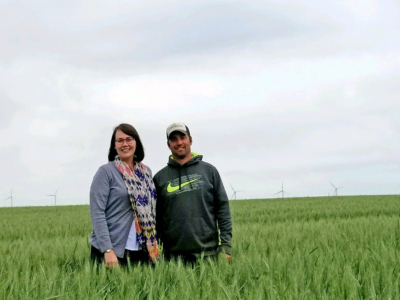
There are 99 counties in Iowa, the state where Oregon Department of Agriculture Director Alexis Taylor grew up on a 159-year old family farm. So maybe the prospect of visiting all 36 Oregon counties in her first year at ODA didn’t seem as daunting.
But none of those Iowa counties come close in size to Malheur, Harney, or most others located in Oregon. It is also likely that the agricultural production, topography, and issues of Oregon’s 36 are much more diverse. Nonetheless, by the middle of January 2018, Director Taylor achieved her goal of stepping foot in each Oregon county within her first year— talking, listening, observing, and learning as well as appreciating the people and places that are woven into the fabric of Oregon agriculture.
“President Eisenhower has a quote that is framed in my office,” says Taylor. “It reads, ‘Farming looks mighty easy when your plow is a pencil and you are a thousand miles away from a corn field.’ This was my opportunity to not be a thousand miles from a corn field, or a cattle ranch, or a pear orchard, or any number of the diverse types of farm and ranch operations we have in Oregon.
“Being new to the department and to the role of director, I knew not everyone was going to travel to Salem to meet me, nor should they,” says Taylor. “This was my opportunity to learn from farmers and ranchers and build a resource that I can call upon as issues arise — have those real-life connections I can rely on when there are questions. I want them to know I will be that advocate for them here in Salem.”
And so, within days of her official arrival to Oregon, Director Taylor set out to take a year-long tour of the state’s agriculture — one county at a time.
Down the Willamette Valley, the director’s tour made its way to Lane County and a visit to hazelnut orchards as well as Springfield Creamery. Benton County farm tours coincided with a keynote address by Taylor to the Oregon State University Agricultural Executive Council and visiting FFA students during “Ag Days.”

After Memorial Day, Director Taylor made her way to Eastern Oregon with a stop at the Umatilla County wheat ranch of Board of Agriculture member Tyson Raymond, who helped show the role of federal conservation programs and their widespread implementation in the region.
“Just having the opportunity for the new director to come to our part of the state and see the ag practices employed by growers in our region was most valuable,” says Raymond. “My only expectation was that she come with an open mind and willingness to learn something new. She absolutely did that.”
From a wheat ranch in Umatilla County to a cattle ranch in Baker County, Taylor next met up with Curtis Martin, one of the leaders of Oregon’s cattle industry. That part of the tour encompassed Union County.
“Alexis is a very keen listener who gives full attention to the subject,” says Martin. “As an example, the first day was spent on focusing on irrigation in the Baker Valley. Although Alexis was not familiar with irrigation or the water code of Oregon, she really keyed into understanding the basics. The questions she asked were absolutely relevant. It was very apparent she was intent on gaining a better understanding. I sincerely appreciated that important interest in the dry climate of Eastern Oregon.”
While in the Columbia Basin, Director Taylor went from land to water. A boat trip into the Columbia River with the US Army Corps of Engineers and Mark Porter of ODA’s Noxious Weed Control Program focused on a potentially serious invasive aquatic weed — flowering rush.
“Having Alexis out here was great so she could get an idea of the scope, scale, and purpose of our weed control work,” says Porter.
Late June took ODA’s director to Wasco County to look at local conservation projects, weed management, and irrigation technology. In July, Taylor traveled to the Oregon coast to learn more about the seafood industry in Clatsop County. In August, amid fields of golden wheat, the tour centered on north central and northeast Oregon counties. In Sherman County, Taylor saw the interface between dryland wheat production and wind farms.
During that week in mid-August, Taylor saw six counties in six days — Sherman, Gilliam, Morrow, Wallowa, Grant, and Wheeler. Along the way, she spent time with two noteworthy cattlewomen — Cory Carman in Wallowa County and Sharon Livingston in Grant County.
Looking back, Director Taylor says there were several themes that cut across all Oregon counties.
Innovation: “Whether it’s the tree fruit industry using laser optics to improve sorting and packing, the use of drones in precision agriculture, or robotic milkers in the dairy industry, all sectors of Oregon agriculture use modern technology to continue to produce a high-quality product in a more efficient way.”
Water: “Farmers and ranchers value water because it is essential to produce crops and livestock, but also because of its importance to fish, wildlife, and all Oregonians.”
Labor: “I heard about work force issues, around immigration challenges and what’s going on federally, and how that trickles down to Oregon. Our growers need access to labor and a skilled work force.”
Urban/rural divide: “Agricultural communities voice frustration over feeling their economic contributions are not being fully recognized by urban centers.”
The next generation of agriculture: “During every tour, meeting, or roundtable I attended, succession planning and challenges for young people entering agriculture came up. This was a universal topic in every part of the state, regardless of operation size, crop, or production system. The average age of Oregon farmers is getting older. Who is going to take over and continue raising that innovative, high-quality food that we are used to in Oregon?”
The wealth of information gleaned through the director’s 36-county tour has been incorporated into ODA’s five-year strategic plan. A specific example is the identification of a key objective in the plan to connect youth with the many and varied potential careers in agriculture that will need filling in the years to come.
In the meantime, Director Taylor vows to continue to spend time across the state. While it won’t be quite as grueling as visiting 36 counties, it’s just as much of a commitment.
“I will always believe it’s very important to get to every part of the state every year,” says Taylor. “While my visits in year one may have been my first time to a certain region, county, or town, it won’t be my last. People can expect to see me around the state throughout the year.”








